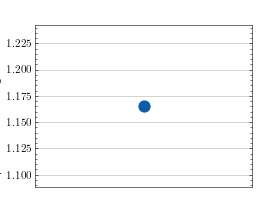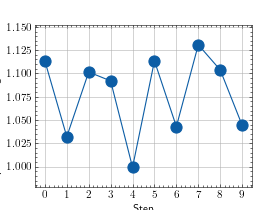Complex Scale-Invariant Signal-to-Noise Ratio (C-SI-SNR)¶
Module Interface¶
- class torchmetrics.audio.ComplexScaleInvariantSignalNoiseRatio(zero_mean=False, **kwargs)[source]¶
Calculate Complex scale-invariant signal-to-noise ratio (C-SI-SNR) metric for evaluating quality of audio.
As input to forward and update the metric accepts the following input
preds(Tensor): real float tensor with shape(...,frequency,time,2)or complex float tensor with shape(..., frequency,time)target(Tensor): real float tensor with shape(...,frequency,time,2)or complex float tensor with shape(..., frequency,time)
As output of forward and compute the metric returns the following output
c_si_snr(Tensor): float scalar tensor with average C-SI-SNR value over samples
- Parameters:
kwargs¶ (
Any) – Additional keyword arguments, see Advanced metric settings for more info.
- Raises:
ValueError – If
zero_meanis not an boolTypeError – If
predsis not the shape (…, frequency, time, 2) (after being converted to real if it is complex). Ifpredsandtargetdoes not have the same shape.
Example
>>> import torch >>> from torch import tensor >>> from torchmetrics.audio import ComplexScaleInvariantSignalNoiseRatio >>> g = torch.manual_seed(1) >>> preds = torch.randn((1,257,100,2)) >>> target = torch.randn((1,257,100,2)) >>> c_si_snr = ComplexScaleInvariantSignalNoiseRatio() >>> c_si_snr(preds, target) tensor(-63.4849)
- plot(val=None, ax=None)[source]¶
Plot a single or multiple values from the metric.
- Parameters:
val¶ (
Union[Tensor,Sequence[Tensor],None]) – Either a single result from calling metric.forward or metric.compute or a list of these results. If no value is provided, will automatically call metric.compute and plot that result.ax¶ (
Optional[Axes]) – An matplotlib axis object. If provided will add plot to that axis
- Return type:
- Returns:
Figure and Axes object
- Raises:
ModuleNotFoundError – If matplotlib is not installed
>>> # Example plotting a single value >>> import torch >>> from torchmetrics.audio import ComplexScaleInvariantSignalNoiseRatio >>> metric = ComplexScaleInvariantSignalNoiseRatio() >>> metric.update(torch.rand(1,257,100,2), torch.rand(1,257,100,2)) >>> fig_, ax_ = metric.plot()

>>> # Example plotting multiple values >>> import torch >>> from torchmetrics.audio import ComplexScaleInvariantSignalNoiseRatio >>> metric = ComplexScaleInvariantSignalNoiseRatio() >>> values = [ ] >>> for _ in range(10): ... values.append(metric(torch.rand(1,257,100,2), torch.rand(1,257,100,2))) >>> fig_, ax_ = metric.plot(values)

Functional Interface¶
- torchmetrics.functional.audio.complex_scale_invariant_signal_noise_ratio(preds, target, zero_mean=False)[source]¶
Complex scale-invariant signal-to-noise ratio (C-SI-SNR).
- Parameters:
preds¶ (
Tensor) – real float tensor with shape(...,frequency,time,2)or complex float tensor with shape(..., frequency,time)target¶ (
Tensor) – real float tensor with shape(...,frequency,time,2)or complex float tensor with shape(..., frequency,time)zero_mean¶ (
bool) – When set to True, the mean of all signals is subtracted prior to computation of the metrics
- Return type:
- Returns:
Float tensor with shape
(...,)of C-SI-SNR values per sample- Raises:
RuntimeError – If
predsis not the shape (…,frequency,time,2) (after being converted to real if it is complex). Ifpredsandtargetdoes not have the same shape.
Example
>>> import torch >>> from torchmetrics.functional.audio import complex_scale_invariant_signal_noise_ratio >>> g = torch.manual_seed(1) >>> preds = torch.randn((1,257,100,2)) >>> target = torch.randn((1,257,100,2)) >>> complex_scale_invariant_signal_noise_ratio(preds, target) tensor([-63.4849])
